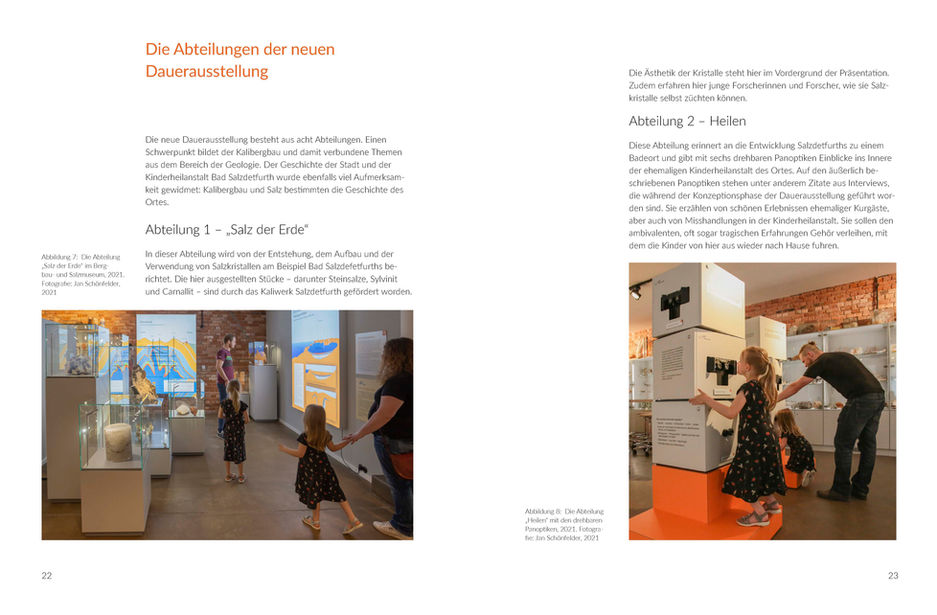Media table Museum Bad Salzdetfurth
Festively opened in 1987
The reopening of the museum in the Saline 2021
A lack of fire protection and accessibility requirements in the old museum building on St. Georgsplatz made it necessary to move to another building.

The museum at St. Georgsplatz
Since In the mid-1980s, the members of the Glück Auf e. V. Bad Salzdetfurth to collect objects and memorabilia for a museum on potash mining. On May 9, 1987, with the support of the Salzdetfurth potash plant and city representatives, they opened a “potash mining museum” under the direction of Obersteiger Ernst Mundel. It was located on the ground floor of the old town hall building opposite St. George's Church. Over the next 28 years, the museum grew thanks to volunteer work and new exhibits: all three floors and the basement rooms of the building were used as exhibition areas and workshops.
A lack of requirements for adequate fire protection led to the closure of the museum in 2015, which at that time had the opulent name “City Historical Brine, Salt and Potash Mining Museum”.
Figure 1: Right attic in the old museum on St. Georgsplatz with the library, pictures of the mine directors and drawings by the artist Gerda Becker (photography 2017)
An impressive collection
The museum acquired several collections and numerous individual items relating to potash mining, the city's history, mineralogy and table salt production. These include objects from the Bad Salzdetfurther Heimatstube such as rare historical flags from the 19th century. They are located in the large drawers under the museum's workbench and can be viewed under supervision. A special treasure are the 59 original drawings by the artist Gerda Becker from Bad Salzdetfurth from 1935. A mineral and ore collection containing several hundred pieces by the mining engineer Helmut Hinke was acquired in 2001.
However, most of the exhibits come from the potash mine in Bad Salzdetfurth, which closed in 1992. The aim of the selection was to be able to draw as comprehensive a picture as possible of the work underground using representative exhibits: means of transport, measuring instruments from the meadow, lighting devices, mine rescue services, signaling systems, drilling equipment and much more are shown.
Figure 2: Helmut Hinke's mineral and ore collection on the first floor of the old museum on St. Georgsplatz; here on a guided tour (photography 2017)


The reopening of the museum in the Saline 2021
After the old museum was closed due to fire safety deficiencies in 2015, the volunteers looked for a new house together with city representatives. The former saltworks at the city's spa gardens had already been on the shortlist when the museum was founded. In 2017, the Hildesheim district housing company acquired the long-unused industrial building and transformed it into a multi-generational home. The city of Bad Salzdetfurth rented the right ground floor for the museum with an exhibition area of 325 m² and an open space of 220 m². A cold hall was built next to the saltworks as a museum storage facility. The planning for the new concept, relocation and construction of the dhowThe exhibition began in 2017 and concluded with the opening of the museum on June 20, 2021. In 2020, the museum received its current name: “Mining and Salt Museum in the Saline”
Figure 3: Opening of the Salt and Mining Museum by Bad Salzdetfurth Mayor Björn Gryschka (photography 2021
Gallery: Mario Müller and Jan Schönfelder: The mining and salt museum in the Bad Salzdetfurth saltworks. Accompanying volume for the reopening of the permanent exhibition on June 20, 2021. With contributions by Karl Grumbrecht, Fredy Köster, Johann Ludyga and Werner Oschlies (Hildesheim: Universitätsverlag Hildesheim, 2021)
Not just a museum
The museum's volunteers from the Glück Auf e. In the 1980s, V. Bad Salzdetfurth made it their mission to keep the knowledge about the former salt production and potash mining alive in their city. The focus was on collecting and exhibiting objects in the museum. When the many references to the former mining industry gradually disappeared after the cessation of potash salt mining in Bad Salzdetfurth in 1992, the miners' association ensured that rope pulleys, trolleys and other large exhibits were set up in open spaces in the city. Together with the city, they continue to support the preservation of historical monuments to this day.
In several publications, the employees of the museum and the Bad Salzdetfurther History Association document. V. - which runs the mining and salt museum in the saltworks together with the city - the history of salt production, the city and potash mining. In recent years, publications have appeared on the potash mine, the children's and youth sanatorium in Bad Salzdetfurth, the spa business and the new permanent exhibition.
"Das Salz machts..."
In 15 Minuten erfahren Sie hier das Wichtigste über den Bergbau in Bad Salzdetfurth, die Entstehung des Salzes und die Gewinnung über die Jahrhunderte.

„Das Salz machts...“ − ein Film von Jan Schönfelder, 2001, im Auftrag des Museums. Fachliche Beratung: Horst H. Hotze. Sprecher: Stefan Wurz
























